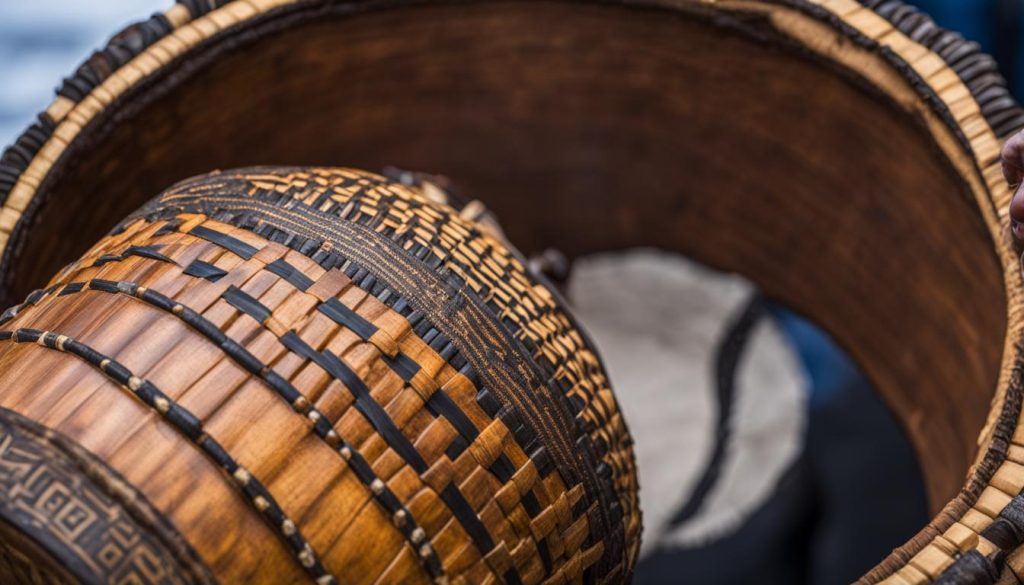Welcome to the captivating world of the djembe drum, an African drumming instrument steeped in rich history and cultural significance.
In this article, I will research the djembe origin and history, exploring its roots within West African culture as a revered traditional musical instrument.
The djembe drum is believed to have originated from either the Bamana people of Mali or the Malinke tribe of Guinea.
With its roots tracing back centuries, this African percussion instrument has played a multifaceted role within various tribes across the region.
Used for communication, ceremonial purposes, and celebrations, the djembe drum has become a symbol of West African culture and a testament to its vibrant musical heritage.
Join us as I journey through the captivating history of the djembe drum, exploring its cultural significance for the Mandinka people and other ethnic groups in West Africa.
Discover how this drum has evolved, shaping modern variants while retaining its traditional African roots.
Finally, uncover the djembe drum’s remarkable significance during the transatlantic slave trade, serving as a powerful tool of resistance and a symbol of cultural pride for the African diaspora.

Content
The Role of the Djembe Drum in African Culture
The djembe drum holds immense cultural significance for the Mandinka people, as well as other ethnic groups in West Africa.
It plays a vital role in traditional ceremonies, rituals, and celebrations, serving as a powerful symbol of African cultural heritage.
The Mandinka people, who are known for their mastery of this percussion instrument, have a deep connection with the djembe drum.
They believe that its rhythmic sounds hold the power to connect individuals with the spiritual realm and ancestors.
The Mandinka people use the djembe drum in various sacred rituals and spiritual practices, allowing them to commune with higher powers and seek guidance.
Beyond its spiritual and ceremonial significance, the djembe drum also serves as a means of communication.
In the vast expanse of West Africa, where long distances separate tribes, the drum is used to convey messages, announce important events, and gather communities together.
The djembe drum is an essential component of African percussion ensembles, adding depth, rhythm, and energy to musical performances.
Its unique tones and versatile sound make it a highly sought-after instrument in contemporary music genres influenced by African rhythms.
To further explore the cultural significance and craftsmanship of the djembe drum, let’s take a closer look at its construction and design in the following table:
| Component | Materials Used |
|---|---|
| Body | Hollowed-out wood, traditionally from the Lenke or Djalla1 tree |
| Head | Goat skin or synthetic materials for modern variants |
| Rope | Stretch-resistant nylon or polyester for stability |
| Playing Techniques | Common hand techniques include bass, tone, and slap |
Through its history and cultural significance, the djembe drum continues to be cherished as an integral part of African identity and heritage.
Its far-reaching influence and ability to bridge cultural gaps make it a symbol of unity, rhythm, and the rich tapestry of African percussion.
Historical Evolution of the Djembe Drum
The djembe drum has a fascinating history of evolution, both in its design and the materials used in its construction.
Originally, the drum was crafted using a carved wood base and goat skins, which were stretched tight and held in place using sinew and rawhide. This traditional construction method allowed for the creation of a resonant and dynamic sound, characteristic of the djembe drum.
However, as time passed and the popularity of the djembe spread beyond Africa’s borders, modern variants of the drum began to emerge.
These newer versions incorporated innovative materials that offered enhanced durability and stability.

The modern djembe drum now utilizes stretch-resistant nylon and polyester rope, which are specifically designed to withstand the tension required to keep the drumhead securely in place.
This evolution in materials has allowed the djembe drum to adapt to different environments and climates, making it a versatile instrument that can be played in various settings.
Despite these advancements, the djembe drum still retains its traditional African roots.
The incorporation of modern materials has not compromised the essence or authenticity of the instrument but rather has allowed for its wider appreciation and usage around the world.
The Significance of the Djembe Drum in the Transatlantic Slave Trade
The djembe drum played a significant role during the transatlantic slave trade. Slaves brought from West Africa to the Americas carried their cultural traditions with them, including the playing of the djembe drum.
The drum provided a means of communication, preservation of traditions, and a source of strength and resistance against the oppressive system of slavery.
Despite attempts to suppress the use of the drum, the djembe continued to resonate with the African diaspora, serving as a symbol of resilience and cultural identity.
| Importance of the Djembe Drum in the Transatlantic Slave Trade | Effects on Cultural Identity |
|---|---|
| 1. Communication Tool: Slaves used the djembe drum to communicate secretly and coordinate resistance efforts. | 1. Cultural Preservation: Despite the hardships of slavery, the djembe drum served as a way to preserve African cultural traditions and maintain a connection to ancestral roots. |
| 2. Source of Strength and Resistance: Playing the djembe drum allowed slaves to express their emotions, invoke a sense of community, and find strength in their shared heritage. | 2. Resilience and Empowerment: The djembe drum became a symbol of resilience and empowerment for enslaved Africans, reminding them of their heritage and their ability to overcome adversity. |
| 3. Preservation of African Musical Traditions: Despite the challenging circumstances, the djembe drum helped preserve African musical traditions in the Americas, influencing the development of various music genres such as jazz, blues, and Afro-Caribbean rhythms. | 3. Cultural Identity: The continued use of the djembe drum by the African diaspora showcases the enduring cultural identity and legacy of African roots in the Americas. |
Wrap It Up
The djembe drum holds a profound significance in West African culture, reflecting its rich origin and history.
As an African drumming instrument, the djembe has captivated the hearts of people worldwide, becoming a cherished symbol of cultural heritage.
Its rhythmic beats transcend language barriers, allowing it to communicate and unite communities uniquely and powerfully.
Throughout its evolution, the djembe drum has retained its West African roots while adapting to modern variations.
From its earliest days, crafted with carved wood and goat skins, to the use of durable ropes in contemporary versions, the djembe has remained recognizable and revered.
This instrument’s ability to evoke emotion and create a sense of connection with the spiritual realm has made it an integral part of traditional ceremonies, rituals, and celebrations.
As the djembe drum played a significant role in the transatlantic slave trade, it carried the weight of resilience and cultural identity.
Despite attempts to suppress its use, the djembe persevered, becoming a symbol of strength and resistance for the African diaspora. Its enduring appeal continues to resonate globally, honoring the traditions and heritage of West African culture.
Today, whether experienced in its traditional form or modern adaptations, the djembe drum stands as a testament to the power of music to transcend boundaries.
It remains a cherished instrument, offering a gateway into the vibrant world of West African culture and serving as a testimony to the innate human desire for connection through rhythm and sound.
